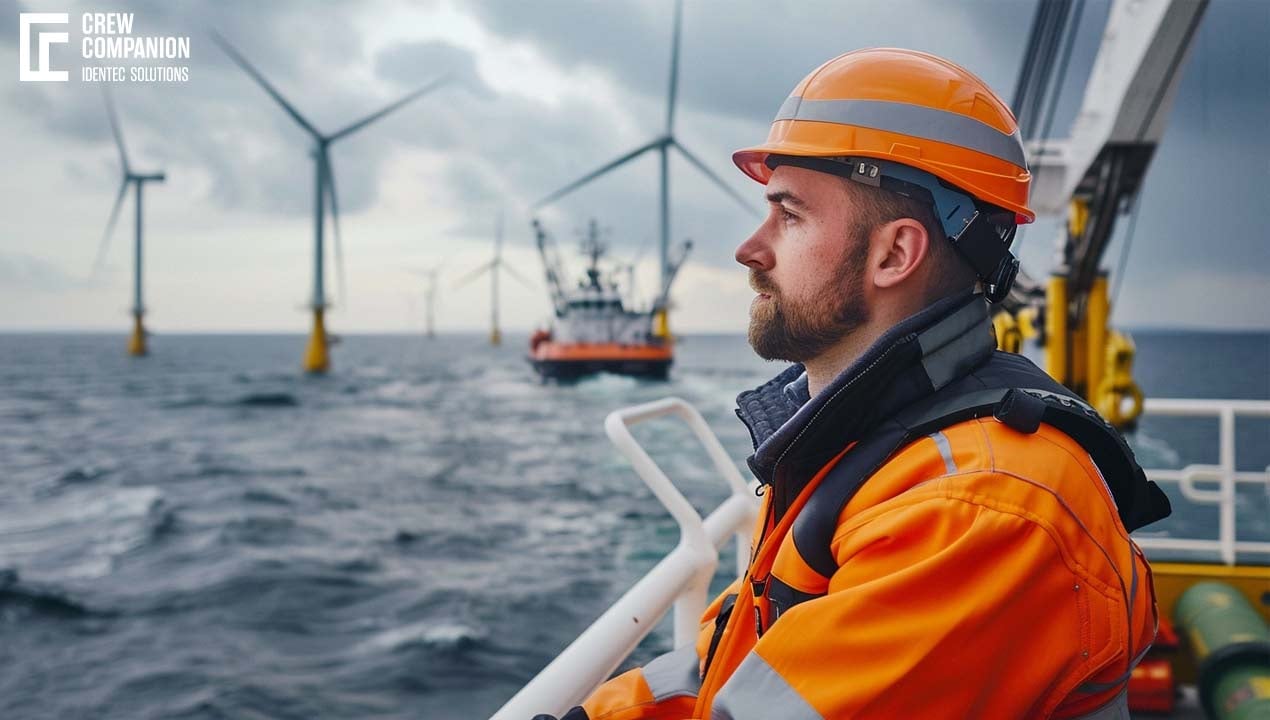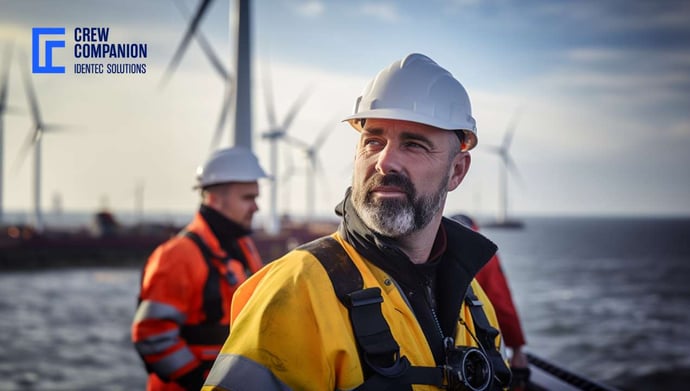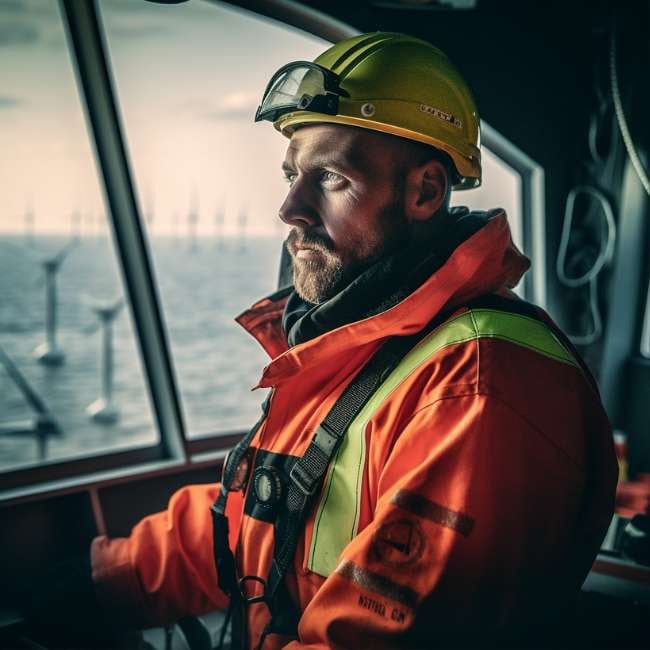EHS Risk management: Calculating offshore risks
| Written by Michal Wozniakowski-Zehenter
Offshore wind projects are important for producing green energy, but they've got special challenges related to the environment and keeping people and workplaces safe. It's crucial to handle these risks well so nobody gets hurt, the environment stays okay, and it works in the long run.
This article discusses how you figure out and deal with the safety and health risks at sea wind power places, and it points out how crucial the boats are for doing many jobs - EHS Risk Management is needed!

No video selected
Select a video type in the sidebar.
When dealing with risks in offshore wind parks, it's focused on spotting, studying, judging, and then doing something about anything that might go wrong; this starts with a serious risk check-up that enjoys into what makes working out at sea special, spots what could go wrong, and thinks about how likely those things are and how bad it would be if they happened. It thinks about phenomena like really bad weather and how far away from land these places are, and it looks at everything from how the wind turbines are made and used to how you build them, keep them working right, and move items and people around.
Vessels play a critical role in these operations, and each type brings its own risks. For example, Crew Transfer Vessels (CTVs) and Service Operation Vessels (SOVs) are essential for moving workers but face risks like rough seas and health issues from working in tight spaces for long periods (read also more about walk-to-work system design). EHS experts use dynamic risk assessment tools that adjust to new information, including sea conditions, weather, and vessel positions, to manage these challenges.
EHS RISK MANAGEMENT – QUANTITATIVE RISK ASSESSMENT
Quantitative Risk Assessment, or QRA, is a set process used to figure out the EHS risk assessment that comes with dangers in a clear-cut way; this method predicts how big the bad results could be if a hazardous event occurs and how often these events might happen. By putting these factors together, it calculates risk into numbers, and it pays a lot of attention to the risk of people getting hurt or dying. It’s really important to look at every possible dangerous event if we want to correctly measure the total level of risk. Dangerous events that are essentially the same get put into one category and are looked at together, which makes looking at the risks quicker and easier.
The process sticks to a normal risk assessment way that has several set steps: first, they identify all the potential dangers, then they see what negative consequences could happen from those dangers, then they figure out how often those dangers could happen, then they add up all the risks and think about them, and lastly, they try to figure out how to reduce the risks.
It all starts with spotting the possible dangers, which is extremely important for understanding risks. Depending on the EHS study's goal, they use different ways to notice the dangers, and one crucial way is to check where hazardous materials could leak or come from since that's really key for figuring out the risks.
The process proceeds by identifying isolatable sections within the study's scope. For each section, potential failure scenarios are mapped out based on the specific failure modes that could lead to a loss of containment. Subsequently, a series of consequence chains is developed for each failure scenario, illustrating the possible hazard outcomes.
The next step involves calculating the effects and consequences to assess the potential injury risk to people stemming from the identified failure scenarios. This analysis leverages models for release rate, dispersion, and fire and explosion impacts. Software tools such as SAFETI OFFSHORE, developed by Norwegian company DNV-GL, are utilized for these calculations, ensuring the use of sophisticated modelling tools. Any key assumptions made during these calculations are meticulously recorded in the Assumption Register.
Estimating the likelihood of a leak for each failure scenario is done by referring to generic leak frequencies found in historical databases such as the TNO Purple Book, UK HSE, UKOPA Pipeline Fault Database, or the OREDA Database. With these frequencies in hand, event trees are constructed to map out the sequence of events starting from the initial failure, using probabilities for each event branch to determine the frequency of the final hazard outcomes.
Risk Summation is then carried out, merging the consequences and likelihoods of all incident outcomes from the selected incidents to produce an overall measure of risk. The SAFETI OFFSHORE software is crucial here, facilitating the summation process. It calculates the likelihood of outcomes leading to fatality, based on the data provided in the Assumption Register, and subsequently generates the overall risk metrics. The outcomes of this quantification are presented as Location Specific Individual Risk & Individual Risk Per Annum, offering a clear view of the risk landscape.
Upon completing the risk estimation, several follow-up activities are undertaken. Sensitivity studies are conducted to delve into the uncertainties surrounding the risk estimates, providing deeper insights into the reliability of the risk figures. The risk analysis is updated to reflect the potential risk reduction measures, showcasing the risk benefits of implementing such measures in an ALARP (As Low As Reasonably Practicable) demonstration. Lastly, bow-tie diagrams are prepared, offering a visual representation of the risk management process, from hazard identification through to mitigation strategies. This comprehensive approach ensures a thorough understanding and management of risks, underpinning safety and reliability in operations involving hazardous materials.

EHS RISK MANAGEMENT – TRANSFERRING FROM CTV
As with most other operations, the transfer of personnel shall be covered by the company's risk assessment system, but since this operation is variable, the Ship Master has to assess the risk locally again each time to figure out if it's okay to proceed. Every location has different conditions based on exposure, local weather and environmental conditions, and the transfer system. When assessing the risk reduction to transferees, the use of additional (dis)embarkation equipment: gangways, steps or ramps should be considered.
After all, personnel involved have been briefed and the Ship Master has given direct instructions, only then should the transfer happen. Unless under the direct control of the vessel crew, no personnel should (dis)embark on a CTV or enter the 'transfer area' of a CTV. The welfare and control of passengers shall be managed to safeguard and protect those onboard from injury or illness. This includes the proactive use of seating and personal securing apparatus (seat belts or harnesses) during transfer to the operational site while the vessel is manoeuvring alongside a berth or an asset.
Assuring that passengers are changed and seated before the vessel undocks from a boat landing since free movement can cause injury, especially if passengers are focused on something else. It's natural that different assets will operate differently (wind turbines, offshore substations, oil and gas structures, construction platforms, construction vessels, accommodation units), so it's not surprising. In a pre-task toolbox talk, all those involved in the transfer should discuss what commands, actions, and equipment they expect to use (personal protective equipment, transfer hardware, and lifting apparatus).
Before transferring, the crewmember ensures the transfer location is safe and free of lifting operations, that any necessary fall arrest equipment is available, that the ladder doesn't grow, and that the vessel is stable. When transferring back onboard, the crewmember should always count down the last five rungs. Any crew member who is preparing to transfer needs to make sure they're wearing the right PPE and be aware of any signs that personnel may not be fit to make the transfer, like if someone has a pre-existing illness or is seasick during the trip. As a control measure for quickly identifying the happening and location of an MOB, the use of Personnel Locator Beacons or Personal RFID Tags onboard CTVs has become a good practice in the industry (see also: Worker safety monitoring). However, control systems aren't often tested or prepared properly in conjunction with other onsite stakeholders' equipment selection or vessel bridges.
WALK-TO-WORK RISKS
Using the walk-to-work gangway from a Service Operation Vessel (SOV) to a wind turbine can be dangerous because the ocean is always moving and can be unpredictable. Big waves, hard winds, and not being able to see well can make switching from the boat to the turbine risky, and you could get hurt or have an accident. When the boat, transfer system; and turbine all move differently, it's tough to stay steady, which could make someone slip or trip. Plus, there's an enormous chance of falling from high when doing these transfers, especially if you're not wearing a safety harness correctly or if the safeguards aren't in place.
Lifting items and being in abnormal positions while moving things around can hurt your muscles and bones. Also, people who work outside have to deal with weather like being extremely cold or hot, or the sun’s harmful rays, which isn't great for your health if you're not careful. Plus, if the equipment like walkways or the baskets people get carried in breaks down, because maybe nobody made sure they were working right, that can be risky too. It shows why it’s extremely important to keep checking and fixing the equipment regularly.
If things bump into each other or get smacked around because they hit parts of the machine that moves items or the big windmill part, people can get hurt. Also, trying to get workers out of the windmill and onto the safety boat when things go wrong can be tough, especially if the weather stinks; to stop people from getting hurt, we must be extremely careful and follow a lot of safety rules; that means everybody has to learn all the safety steps, wear the right safety gear, follow all the instructions extremely well, and use these cutting-edge walkways that adjust to the motion so people can move between the boat and the windmill without problems. It's also very important to keep an eye on the weather and ocean phenomena all the time and be ready for emergencies so we can keep everyone safe when they're going between the boat and the windmill.
CONSIDERATIONS FOR EMERGENCY RESPONSE AND PREPAREDNESS
While robust EHS risk management is at the very core of any offshore wind operation, effective emergency response plans complement such strategies. The peculiar difficulties of the offshore environment create demand for comprehensive preparation against any incident that could disrupt an operation or put personnel at risk.
First, an emergency response strategy should be proactive in nature and take shape in the form of a tailored ERP for specific conditions of every offshore site, including all possible scenarios such as severe weather conditions, equipment failures, medical emergencies, and vessel incidents. This is paramount in ensuring the capability and readiness of the crew to respond without delay since any delays in rescue operations may prove to be quite serious since offshore wind farms are basically isolated.
The other important elements of a good ERP include regular training and practice in various emergency scenarios. This would also encompass training in MOB procedures, emergency evacuation procedures, and first aid related to the most common types of offshore work injuries. Such training consolidates the crew members' knowledge of emergency response procedures, which is the most important thing during the escalation of high-intensity situations, where swift, combined measures can decide between disaster and safety. Another important principle of preparing for emergencies is good communication. There must be some means of reliable communication between each offshore installation and the onshore control centre to facilitate quick coordination during times of emergency. Advanced technology, like satellite communication or automated distress signals, will contribute much toward improving response times and ensuring accuracy in disseminating information. Besides that, the cooperation with rescue services and coast guards at a local level also gives the additional assurance that reinforcements can be summoned easily if required. Lastly, the fitting-out of all personnel with emergency survival kits, proper PPE, and location devices like PLB or RFID tags add to the personal safety and ability to locate them in case of searches. As such, emergency equipment integrated into these wind turbines needs to be updated and inspected periodically in order to ensure its proper function reliably. The implementation of these in an integrated part of the wider EHS risk management approach shows evidence of safety and preparedness commitment that is so crucial to protecting workers and handling projects successfully within the industry.
FAQS
How do you complete an EHS risk assessment?
EHS risk assessment is a systematic process to ensure workplace safety and environmental protection, which can be done independently or with expert assistance. It involves identifying potential hazards, assessing associated risks, implementing control measures, documenting findings, and regularly reviewing controls. This approach prioritizes risks, ensures legal compliance, and maintains high safety and environmental standards through continuous improvement.
What are the biggest risks in offshore wind farm operations?
Offshore wind farm operations face significant risks, including harsh weather conditions, logistical challenges in maintenance and repair, complex installation processes, electrical system vulnerabilities, occupational health and safety hazards, potential environmental impacts, and stringent regulatory requirements. These risks necessitate comprehensive management strategies, incorporating advanced planning, technology, and adherence to safety and environmental standards to ensure sustainable operations.
TAKEAWAY
In conclusion, effective EHS risk management in offshore wind operations involves a structured approach from hazard identification to continuously monitoring mitigation measures. By carefully assessing risks and implementing targeted mitigation strategies, the offshore wind industry can ensure the safety of its workforce, protect the environment, and maintain operational integrity, thereby supporting the sustainable development of clean energy from offshore wind resources (for the Oil and Gas sector, see also: Retrofitting a mustering solution as a FPSO project).
Delve deeper into one of our core topics: Personnel on board
Sources:
(1) https://www.nopsema.gov.au/sites/default/files/documents/2021-03/A462124.pdf
(2) https://www.sciencedirect.com/science/article/abs/pii/S0925753501000480
Note: This article was updated on the 5th of November 2024

Author
Michal Wozniakowski-Zehenter, Marketing Manager
Michal Wozniakowski-Zehenter is an experienced marketing and project management professional. He spent most of his career on projects with a strong focus on digital marketing and event management. He is a very active voice representing offshore and mining industries through social media channels. Michal writes mainly about offshore oil and gas, renewable energy, mining and tunnelling. Compiling and sharing the knowledge within industries is one of his goals.





